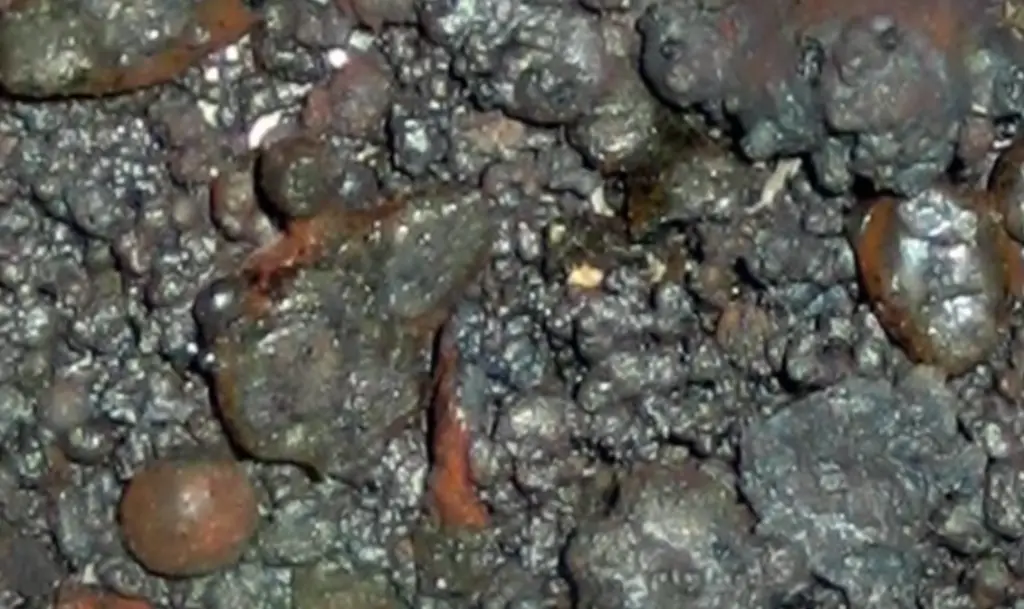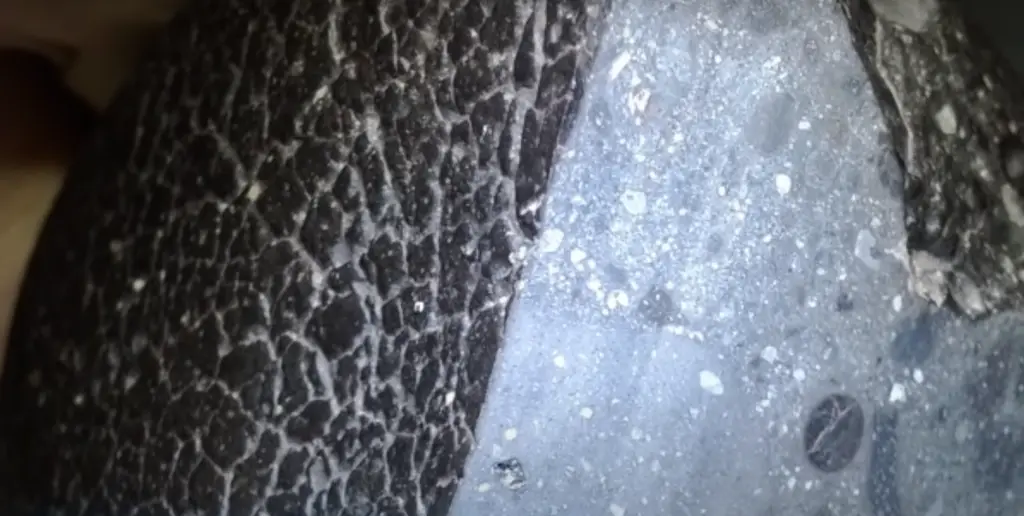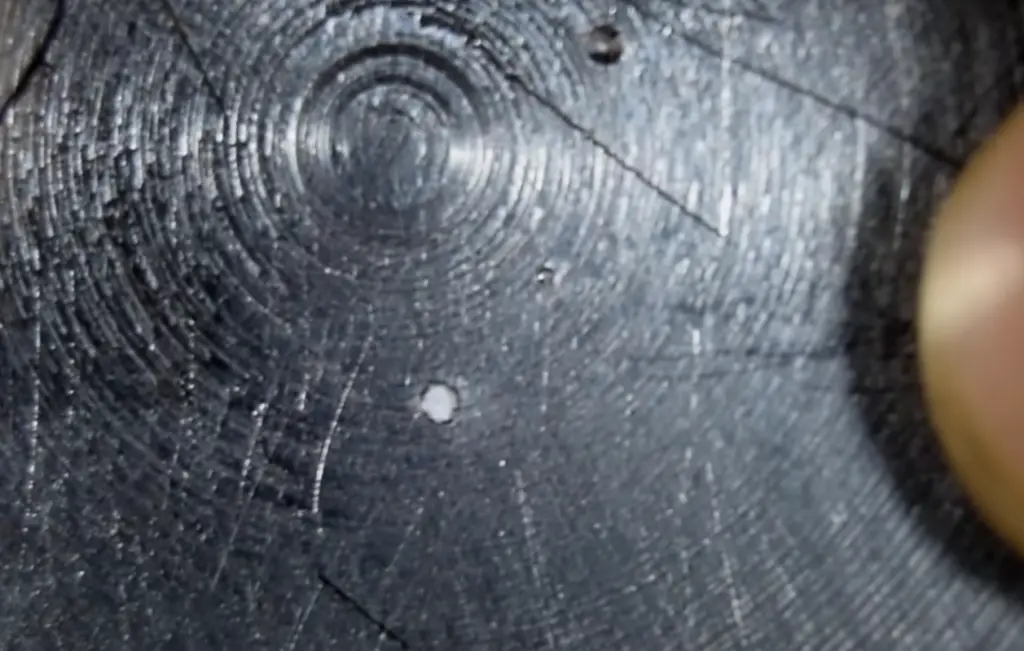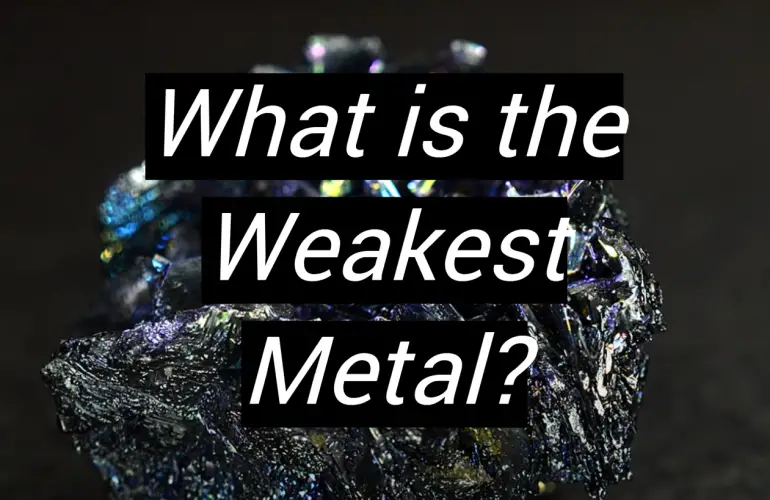What is the weakest metal on Earth? This question has puzzled scientists and researchers for years. Some believe that it might be aluminum, while others think that it could be magnesium.
Steel is the most durable metal on Earth. There are four distinct types of metals that are less strong than steel. Mercury is the weakest since it is liquid at room temperature.
Gallium and Iridium are the lightest and least dense, with densities of 22.4 g/cc respectively.
The highest strength is in osmium and tungsten, with a rating of 1510 megapascals [1].
But what is the answer? In this blog post, we will explore the various metals on Earth and try to determine which one is the weakest. Stay tuned!
What Is The Weakest Metal
Mercury
Mercury is the weakest metal. It is a liquid at room temperature and pressure, so it can’t support much weight.
This makes it worthwhile in some ways (such as being used in thermometers) but means that it isn’t strong enough to be used for most purposes.

Metal atoms readily share valence electrons with other atoms. The mercury atom’s electrons are more tightly bound to the nucleus than usual. In fact, the s electrons move at such a high speed and near the nucleus that they behave like relativistic particles, appearing to be heavier than slower-moving electrons.
It takes very little heat to break the loose connection between mercury atoms. Mercury has a low melting point, is an inefficient electrical and thermal conductor, and does not form diatomic mercury molecules in the gas phase because of its valence electron behavior [2].
Gallium
This metal is often used in semiconductor manufacturing. It has a very low melting point, which makes it ideal for use in electronic devices. However, gallium is also very brittle and can easily be broken.
This means it is not very strong and can easily be bent or crushed.Gallium is a liquid metal that is only slightly above room temperature when melted. Gallium’s pure solid form is fragile and has poor electrical conductivity. Gallium exists in just 0.5 mm3 of the body fluids in each person.
Gallium is a soft, colorless metal with a melting point of only 29.76 degrees Celsius. It will melt if you hold it in your hand and attempt to melt it, but the process takes time and leaves your palm sticky. Melting gallium in your hand isn’t very impressive—but it’s not dangerous to do so [3].
Some gallium applications include:
- Semiconductor;
- Solar cells;
- LEDs;
- Computer memory chips;
While gallium is not the weakest metal, it is certainly one of the more fragile metals. Its low density also makes it less than ideal for many applications. However, its unique properties make it essential in semiconductor manufacturing and other high-tech industries. Therefore, while gallium may not be the strongest metal, it still plays an important role in our world.
Iridium
This metal is number three on the list of weakest metals. It is also one of the rarest metals on Earth. Its rarity and its high melting point make it very difficult to work with.
Iridium has a hardness of about 22.0 on the Mohs scale. It is mostly used in alloys, and for coating other materials.

Iridium is a transition metal of the platinum family that is hard, brittle, lustrous, dense, and silvery-white. It has a silvery-white color and is known for its corrosion resistance. It resists air, water, and acids.
Iridium’s popularity stems from its use in electronics, automobiles, and the chemical sector, where it is used to coat electrodes in the Chlor-alkali process and catalysts.
Although pivot bearings and scientific and other specialized equipment are used in some cases, it is mostly utilized in alloys: osmium/iridium alloys are utilized for fountain pen nib tips and compass bearings [4].
Osmium
This metal is often considered to be the weakest. This is because it is very brittle and can easily break under pressure. It is also not very strong, which makes it susceptible to damage from other elements.
Despite its weaknesses, osmium is still used in some industries because it has some unique properties. For example, it is one of the heaviest metals on Earth and has a very high melting point. These characteristics make it useful for certain applications, such as in aircraft engines.
Osmium has few applications. It’s used to make extremely hard alloys for fountain pen tips, instrument pivots, needles, and electrical contacts, as well as a catalyst in the chemical industry. Osmium does not appear to have any biological purpose [5].
Therefore, while osmium may not be the strongest or most durable metal, it still has its place in the world. Who knows, maybe one day scientists will find a way to harness its unique properties to create new and innovative products!
Tungsten
Tungsten is an element with the highest melting point and the second-highest density. It is also one of the hardest metals. However, tungsten has a relatively low Young’s modulus and a low shear modulus. This combination of properties makes tungsten very brittle. In fact, tungsten is so brittle that it can be easily pulverized with a hammer.
For these reasons, tungsten is not often used in engineering applications. Instead, other metals such as steel are typically used instead.Tungsten is currently used as electrodes, heating elements, and field emitters, as well as filaments in light bulbs and cathode ray tubes. Tungsten is a common component in heavy alloys such as high-speed steel, from which cutting tools are manufactured. It’s also utilized in super-alloys to create wear-resistant coatings [6].
Why Is Mercury The Weakest Metal?
Mercury is a dense, silver-colored d-block element that is the only metallic substance that is liquid under normal conditions of temperature and pressure; bromine, though metals such as caesium, gallium, and rubidium melt just above room temperature.
Because water dissolves easily in all metals, including mercury, it is a soft metal. All metals have free electrons as do all other elements, therefore they are excellent conductors of electricity. Metals exchange their free electrons for positive ions to form chemical bonds. This is how metals are able to hold their shape [7].

Mercury has a very strong affinity for oxygen, so it forms oxides readily. The resulting mercury oxide is a very weak conductor of electricity. This is why mercury-based electrical switches are not used in common household appliances.
Even though it’s the weakest metal, mercury still has some important uses. It’s used in dental fillings, barometers, and certain types of light bulbs. It’s also used in the process of gold mining
Metals form ions of charge plus one or two, while a few develop ions of charge three. Non-metals are non-conductors that make negative ions or covalent bonds as opposed to electrons.
What Alloy Is The Weakest On Earth?
The weakest metal on earth is an alloy called Invar. It’s made of 96% iron and only four percent nickel. However, the addition of just a small amount of carbon makes it significantly stronger. Invar is used in applications where a very strong metal is not required, such as in watchmaking and jewelry.
The metal is also used in scientific instruments, such as mass spectrometers because it doesn’t expand or contract with temperature changes [8].
While Invar may be the weakest metal on earth, it’s still incredibly strong compared to other materials.
For example, human bone is only about five times as strong as Invar. And spider silk is only about twice as strong!
Why Are The Strongest And Weakest Metals Different?
The answer to this question is not as simple as it may seem. In order to understand why the strongest and weakest metals are different, we must first look at what makes a metal strong or weak in the first place.
Two primary factors contribute to a metal’s strength: chemical composition and microstructure. The chemical composition of a metal refers to the specific elements that make up the alloy. For example, steel is an alloy of iron and carbon. The microstructure of a metal refers to the way in which its molecules are arranged. This can be influenced by things like heat treatment or cold working.

So, now that we know what makes a metal strong or weak, let’s take a look at some of the strongest and weakest metals in existence.
Some of the strongest metals include:
- Titanium;
- Steel;
- Inconel;
- Chromium;
Some of the weakest metals include:
- Aluminum;
- Copper;
- Brass;
- Zinc;
As you can see, there are varieties of factors that contribute to a metal’s strength or weakness. In general, however, the stronger metals are those with higher carbon content and/or those that have been heat-treated or cold worked. The weaker metals are typically those with lower carbon content and/or those that have not been heat-treated or cold worked.
FAQ
What is the weakest metal element?
The answer to this question isn’t as simple as it may seem. While there are metals that are weaker than others, the term “weakest metal” can mean different things depending on the context. For example, some metals may be weaker in terms of hardness, while others may be weaker in terms of ductility.
In general, however, the weakest metals are those that are most easily corroded or oxidized. Metals such as iron and steel are susceptible to rust and other forms of corrosion, which can weaken them over time. Other metals such as aluminum and magnesium can also be corroded, but they are typically more resistant to these processes than iron and steel.
So, in terms of overall strength and durability, the weakest metals are those that are most easily corroded. However, there are other factors to consider when determining the “weakest” metal, such as hardness and ductility.
What is the most fragile metal in the world?
One of the most fragile metals in the world is probably mercury. Mercury is a liquid metal at room temperature and is very reactive. It easily forms amalgams with other metals, which can cause it to become brittle and break easily.
Mercury is also dangerous to humans and the environment, so it is not often used in commercial or industrial applications.
What is Earth’s weakest material?
The Mohs scale ranks minerals according to their ability to scratch one another when tested under a microscope.
Talc, or soapstone, is the softest mineral and consists of a stack of loosely connected sheets that tend to fall apart when pushed. When it comes to metals, scientists try to quantify hardness in absolute terms [9].
What metal is the strongest?
Impact toughness is a metal’s ability to absorb energy without shattering or fracture. Tungsten, which comes from Sweden and means “heavy stone”, is the world’s hardest material. It is often used in alloys because it can withstand high temperatures and has a very low expansion rate.
Tungsten also has the highest melting point of any metal, at around 6000 degrees Fahrenheit.
While tungsten is the hardest metal, other metals are stronger in terms of tensile strength or resistance to fracture. For example, carbon steel is much stronger than tungsten when it comes to tension and compression. In terms of resistance to fracture, however, tungsten is still the strongest metal [10].
Is gold a weak metal?
Gold is the most malleable of all metals, which makes it incredibly ductile. Pure gold is too soft to withstand the strains of constant usage, so it is made stronger by combining it with various alloying components. Metals such as silver, copper, nickel, and zinc are used in these alloys.
How strong is vibranium?
Vibranium is a metal-free alternative to aluminum and steel. It’s 8 times lighter and 10 times stronger than comparable materials. The smart material may send critical information such as temperature, stability, integrity, and more wirelessly and virtually instantly thanks to its wireless transmission capabilities.
While vibranium is strong, it is not the strongest metal. However, its wireless transmission capabilities make it a unique and valuable material.
Can you melt titanium?
Yes, titanium can be melted. In fact, it has one of the highest melting points of all metals. Titanium can withstand temperatures up to 5432 degrees Fahrenheit.
However, titanium is not the metal with the highest melting point.
That distinction belongs to tungsten, which has a melting point of 10832 degrees Fahrenheit.
That said, titanium is still an incredibly strong and durable metal. It is often used in high-stress applications such as aircraft construction and medical implants.
Titanium does not solidify until it reaches a temperature of 3,034 degrees Fahrenheit [11].
Useful Video: Probability Comparison: Rarest Substances on Earth
References:
- https://whichnwhat.com/what-is-the-weakest-metal/
- https://www.thoughtco.com/why-is-mercury-a-liquid-608454
- https://chemistrytalk.org/gallium-metal/
- https://www.lenntech.com/periodic/elements/ir.htm
- https://www.rsc.org/periodic-table/element/76/osmium
- https://www.rsc.org/periodic-table/element/74/tungsten
- https://www.quora.com/Why-is-mercury-a-weak-metal
- https://www.sciencedirect.com/topics/chemistry/invar
- https://www.quora.com/What-is-weakest-material-on-the-earth
- https://www.industrialmetalsupply.com/blog/what-are-the-strongest-metals
- https://monroeengineering.com/blog/6-surprising-facts-about-titanium






